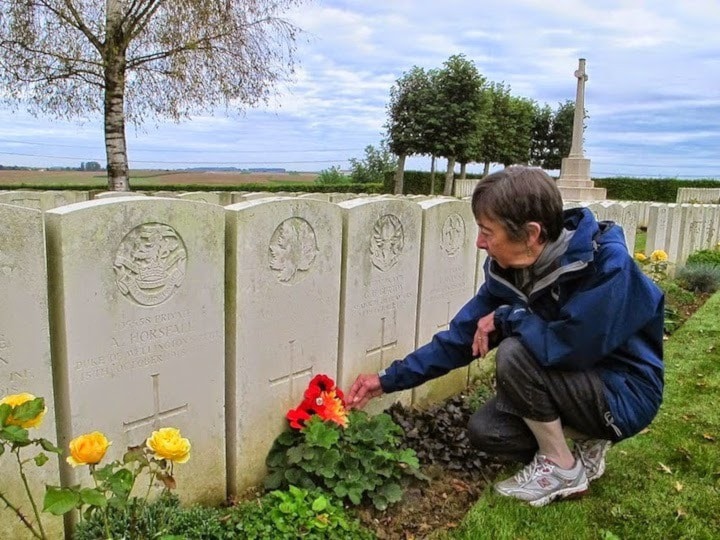Fourth in a series marking the centennial of the First World War
Annie Garland Foster never visited her husband’s grave.
The first woman to sit on Nelson city council married William Garland Foster, editor of the Daily News, in early 1915. He had already enlisted with the 54th Kootenay Battalion and been sent to Esquimalt for officers’ training when he proposed.
As Annie recalled in her memoir: “Then he arrived suddenly one day after Christmas holidays and announced that we were going to be married. Just like that!” The war hastened their union.
The ceremony, which surprised friends and colleagues, was a low-key affair at a Vernon Street home on a Saturday evening with few others present.
Rather than leave on a honeymoon, the couple almost immediately parted as William returned to his post; Annie travelled with him by train as far as she could, then retraced her journey so she could be back at her post Monday morning as principal of Hume school.
By June, Garland Foster was stationed in Vernon, and Annie joined him there until the 54th Battalion departed for Halifax a few months later under the command of Lt.-Col. Arnold G. Kemball of Kaslo.
Annie and her husband, who was promoted to captain, briefly reunited in Ottawa with his family before he went overseas and she went to stay with her parents in Woodstock, N.B.
When word came in 1916 that Garland Foster was in hospital with pleurisy, she sailed for Britain. By the time she arrived, he had recovered sufficiently to meet her at the train station in London, and they enjoyed a short time together touring the city.
After three months, Annie — a trained and experienced nurse — offered her services to the Canadian army medical corps. She was ruled ineligible as she was married, but offered a position with the British Red Cross and began working at Percy House military hospital in Middlesex.
She met her husband as often as possible until the 54th left for the battlefields. They briefly reunited ten months later in London. Annie later wrote: “I shall never forget the day I took leave of him after his holiday … One saw him get into his train, with a sort of suspended animation feeling … I knew the moment had come. Leaving life, happiness and all that home had meant to us behind.”
Annie continued to treat convalescing soldiers for a few more months, but pregnant with twins, she decided to return to New Brunswick. Sadly, she miscarried during a dreadful crossing of the Atlantic.
A month before the armistice, her family read that two adjutants had been injured close to where the 54th Battalion was engaged. Several days later, William was confirmed as among them, having suffered shrapnel and lung wounds. Once again, Annie wanted to go to him, but her travel plans were stymied. Two weeks later she received the painful news of William’s death. He was posthumously awarded the Military Cross.
Annie returned to Nelson, where she still owned a home. She resumed teaching, became active with the Great War Veterans Association, and was elected to city council in 1920.
Emotional visit
Frances Welwood, who in 2011 wrote Passing Through Missing Pages: The Intriguing Story of Annie Garland Foster, spent three weeks in France in September with husband Ron.
After a week with friends near Nice, they drove across the country to Picardy and stayed in the town of Arras, near the Belgian border — the centre of the most desperate conflicts of the First World War. They visited the Vimy Ridge Memorial and its two adjacent cemeteries.
“The impact and emotion of the Vimy Ridge site on a sunny, blue and white morning cannot be overstated,” Frances says. “We certainly were impacted by our brief encounter with grim battlefields, but in particular the so very silent, pristine cemeteries of Normandy and Picardy.”
Ron adds: “It was an unexpected and grim surprise to see such a great number of 54th names at the smaller Givenchy Road Cemetery.”
They found Lt. Col. Kemball’s grave at the small St. Villers-au-Bois Cemetery and also saw the Beaumont-Hamel Memorial to the Newfoundland regiments who lost about 80 per cent of their large complement on July 1, 1916.
William Garland Foster’s grave, meanwhile, is at Bucquoy Road Cemetery, about 10 minutes from Arras. The Welwoods laid plastic maple leaves at his tombstone — whose chiseled markings are not that distinct — as well as poppies provided by the Nelson branch of the Royal Canadian Legion and a Nelson city pin.
His marker reads: “Captain & Adjt./W. Garland Foster MC/54th Bn. Canadian Inf/14th October 1918/Age 39.”
“We are certain that Annie would have been pleased that we paid this visit,” Ron said.
They’re not aware of any other locals who have been to the grave — even Garland Foster’s great-grandnephew, who is very interested in his family history, has not been there.
While coming through the southern French Alps the Welwoods also spent a day pursuing the little-known story of the World War II resistance fighters of Vercor, one of five areas recognized by the French government.
Ron's grandparents came to Canada from Vassieux-en-Vercor in 1894, but many remaining relatives were massacred by Nazi forces when they entered the village in 1944.
Previous:
